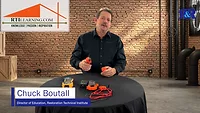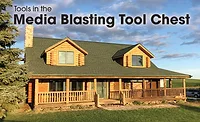Something Old, Something New…
It seems like only yesterday that I first saw abrasive media blasting in use on an architectural restoration job – a fire-damaged, limestone church in central Illinois. I don’t remember all of the circumstances (that was over 18 years ago), but I do remember what happened. It was a chilly morning, with a bright yellow sun – a perfect day for media blasting – cool, dry and (based on my very positive recollections) probably a Friday to boot. The church’s exterior seemed to glow in the morning rays. Inside the proud historical structure, over 75 years old at the time, was very different. The limestone in the attic area was blackened by soot from a recent fire.
The restoration contractor had seen our baking soda blasting process at a tradeshow, or possibly advertised in a trade magazine. The demonstration was not just a “dog and pony show”, but a last ditch effort after many other methods were eliminated, like painting over the soot to cover it, or had failed, like chemical cleaning and pressure washing to name a few. Everyone on the site had high hopes – the general contractor, the insurance adjuster, the church deacon, and a very young, abrasive blasting salesman – that the modified “sand-blasting” machine shooting sodium bicarbonate, or baking soda, with compressed air would clean the soot and charring without damage to the beautiful, nearly white limestone. (See picture #1) Although the picture is quite old, and pixelated – just like my own memory of that day, it still shows clearly the “before” and “after” results of that trial.
That contractor and many others since have discovered that baking soda, dry ice and other media blasting techniques very clearly show successful results (See pictures #2 and #3) - results that would be impossible with “traditional” techniques (i.e. hand sanding, wire-brushing, chem sponging, as well as a number of chemical protocols). That day in May of 1997 was no exception. After the initial trial, the contractor was awarded the job of soda blasting to remove the soot, and the associated clean-up. The trial equipment had found a “forever” home, and the rest was history, or at least fond memories.
It’s fun to think back to those “early days” of blasting’s entre to the architectural restoration trade. Of course until recent times, sand blasting had been used for many years for paint stripping, masonry restoration, and even fire damage restoration. The main problem with this technique is the severe damage caused by the blast media. Only the most robust substrates (i.e. steel, concrete, and some masonry) would be able to withstand the collateral damage caused by the harsh media. Couple this with the health effects of silicosis – a lung disease caused by the inhalation of silica dust, a human lung carcinogen – and sand-blasting is nearly extinct. It’s the advent of the new blasting media, however, that has really brought the blasting process indoors, literally.
With soft, non-damaging media like baking soda, and dry ice, the door was thrown open. Blasting of building materials like soft limestone, most brick and mortar surfaces, even wood (See picture #4 and #5) could be blasted free of contaminants like soot and fire residues, sewage and flood staining, as well as a much more recent contamination, mold growth. (See picture #6)
Mold remediation with abrasive blasting is a relatively recent development. In particular, blasting mold with dry ice has proven to be a very effective method for the “manual” removal of mold from structural materials. By “manual” removal, I’m referring to what the I.I.C.R.C.’s S-520 Mold Remediation Standard refers to as “structural remediation,” involving hand sanding, wire brushing, and in larger contaminations, blasting. Recently a contractor, Complete Restoration & Cleaning Services in Muskegon, Mich., called to discuss this application. Owner Jon Honore described a small ranch home in a resort area that had been vacant for an extended time, due largely to mold infestation.
It was a sick building in a prime neighborhood. The odor of mold was present throughout the structure, but the industrial hygienist indicated that the basement (See picture #7) was the primary problem in the house, with highly elevated mold levels – including inside the cold air returns for the HVAC system. A protocol was devised by the hygienist, at the suggestion of the IICRC certified firm that closely followed the S-520 Standard. The heart of the remediation process was the use of media blasting for manual removal of the mold.
In this case, Complete chose to use dry ice blasting (See picture #8) due to the limited amount of secondary waste, normally present with more traditional blasting media. Dry ice blast media sublimates when blasted against a hard surface directly into a gas – with no liquid. (See picture #9) In essence, the media disappears. This “disappearing” act is what leads so many to comment that “…there’s no clean-up”. Of course, this is not at all the case. Matter, in this case mold, is not destroyed, nor is it “molecularly re-organized,” or whatever the current buzz word is. Matter cannot be created or destroyed by ordinary means. Simply put, mold is mold. “Dead” mold still contains harmful components, and must be treated accordingly. The removal process, and its place in any mold remediation protocol, is crucial to its effectiveness. The manual removal, by means of physical contact with the blast particles in this case, is just one step in the cleaning standard.
Proper containment methods were employed to keep the blasting debris from exiting the work space, as well as from entering “permanent” appliances like the furnace, water heater, etc. (See picture #10 and #11) In addition, the use of air moving equipment assured that the containment was achieved, with negative pressure to spare. (See picture #12) Following the blasting a thorough HEPA vacuuming was employed to remove the blasting debris – consisting mainly of wood fiber, broken down mold particles, and other detritus displaced by the cleaning. Air scrubbers with HEPA level filters were run continuously following the blasting process to clean airborne particulate.
Standards and protocols for cleaning mold have been around for a long time. To my knowledge, the oldest known mold protocol is found in the Old Testament of the Bible. Starting in Leviticus 14:35, the Lord spells out how to deal with mold infestation in a protocol given to Moses and Aaron. I’m not kidding, the Old Testament Standard revolves around the removal of mold, specifically that one “… must have the inside walls of the house scraped. And the scraped material dumped into an unclean place outside the town.” I don’t mean to preach here, but I do want to reinforce the ancient (and current) principle that mold must be removed - not treated, killed or otherwise modified - as the core of standard. Leaving mold in place simply goes against the basic tenet of source removal. Indeed, the final analysis of this effectiveness was in the hands of the same hygienist that devised this particular cleaning protocol.
The effectiveness of the cleaning was visually quite apparent. (See picture #13) Regardless of the appearance, the proper clearance tests were employed, including air samples, tape lift tests, etc. In other words, the typical clearance tests were used by testing firms in these matters. To no one’s surprise, the surfaces that appeared clean were truly clean – even microscopically.
Success in cleaning applications is never a sure thing. The best we can do is to apply the tools we have in the most effective way we know how. The standards and protocols represent that know-how. Additionally, the standards allow for several ways to accomplish this same result – effective cleaning through source removal. It doesn’t matter whether you’re brand new to the restoration industry, or maybe you’re an old timer, abrasive media blasting should be a part of your restoration efforts.
Looking for a reprint of this article?
From high-res PDFs to custom plaques, order your copy today!







